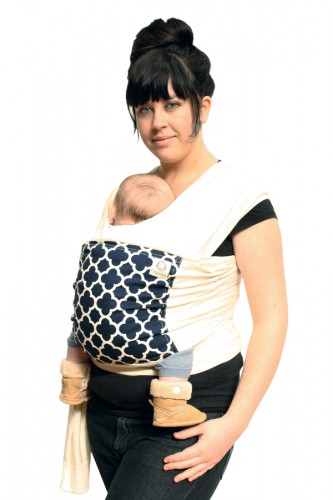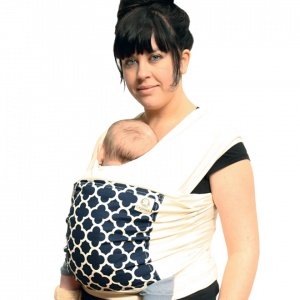
Do you know about the fourth trimester? It’s the first three months after birth, a very special and important time for both parent and child. During this time, baby still has some big developments to complete and Mum has a roller coaster of hormones to manage. Best thing to do is snuggle-up together and act as if you’re still pregnant…like stay in as much as possible and learn to watch for baby’s cues rather than plan a schedule. You can’t “spoil” them at this stage so just enjoy!
The physiology of the fourth trimester
Keeping baby close by, including skin to skin contact where possible, helps to release the hormone oxytocin. Oxytocin’s an important chemical that provides the ‘feel good’ rush directly after giving birth. It’s also released during breastfeeding and it helps your uterus to return to its pre-pregnancy size. The problem is that continuously holding your baby when there are household tasks and other children to attend to is not always practical. A carrier like a stretchy wrap or baby sling then becomes a great aid for maintaining that all important contact and minimising tiredness in a new Mum.
In the fourth trimester, baby will be most at home on your body (or Dad’s) and will get all the right stimulation to continue growing. By meeting that primary need to be held, baby is likely to be calm and settled, which in turn will help you with the roller coaster ride of emotional, instinctual and physical changes going on while you get to know your new born. This closeness can even help avoid post-natal depression. In some cultures baby never gets put down, although usually that means there are a number of family members nearby for support.
With my first born, Madelynn, I used a baby hammock to rest her in and I found both of us slept really well with her so close by. (I napped when she did and healed from an emergency caesarean really quickly). The hammock provides direct benefit to baby, mimicking the feel of mothers arms by gently cradling baby and moving when they do. Once I had my second child Toby, the sling became a necessity. Baby can sleep and even feed while comfortably strapped to you. For them it is much like the womb experience and for you it provides peace of mind knowing baby is safe and sound. As anthropologist Jean Leidloff said in the Continuum Concept, “they come prepared for the great leap from the womb to their place in arms”.
My business, Natures Sway, was born from my personal desire for babies to never be without the familiar protective arms and presence of the parent. My own first 10 days were in a hospital waiting to be adopted. This experience had a deep effect on me and inspired my interest in psychology and the importance of the fourth trimester. I’m sure the nurses would have cared for us babies really well, but nothing beats one on one care and love from a main care-giver. At Bethany Centre for Girls, the birth mothers were and still are encouraged to look after their babies for those 10 legal days before adoption and I believe that imprints on both baby and mothers souls, resulting in a good start for baby and a better chance of healing for the mother and the baby when the separation of adoption does occur. I do wish my own mother had gone there. http://www.salvationarmy.org.nz/our-community/bcm/archives-heritage/photo-week/the-bethany-centre-for-girls
Those primary experiences have been shown to impact on the rest of our lives and there is much research now done to study what kinds of attitudes and treatment give baby the optimal chance for healthy growth physically, emotionally, socially and spiritually. I hope as a society that we can support our new mothers and fathers to be present for their new born babies and take the time to bond and establish love and trust as the building blocks for a productive and fulfilling life ahead.
The fourth trimester – some final thoughts and further reading
“The first three months postpartum are a time of tremendous physical upheaval in a woman’s body, and every woman should know what to expect” –Deborah Bohn
In about three months the quirkiest postpartum effects will have passed, and by six months you should feel like a close representation of your old self. Until then, behave as though you were still pregnant; take care of yourself, eat nutritious foods, dress comfortably, and get as much sleep as you possibly can. Take heart in the fact that you’re on the homestretch and already holding the best prize of all.
http://www.babyzone.com/mom/postpartum-depression/postpartum-depression-fourth-trimester_68237
“Some major development is far from done but we wouldn’t be able to give birth to their giant heads if they stayed in the womb any longer” –Amy Morrison
http://www.ivillage.com.au/the-little-known-fourth-trimester-pregnancy/
Don’t Worry About Creating “Bad” Habits: Yes it’s true – you cannot spoil a new born baby. No matter how much you rock, cuddle, wear, or hold your baby, she is going to turn into an independent little person. Children are not spoiled by love and affection; they thrive on it.
The fourth trimester is a time for mama to heal, and for a newly expanded family to get to know one another. Some mamas refer to this time as a “babymoon.” Much like a honeymoon for newlyweds, the fourth trimester shouldn’t be about schedules or expectations. Instead it – and our babies – should be greeted with patience and wonder.
http://www.becomingmamas.com/life-in-the-fourth-trimester/
Kate Hornblow
Email: kate@naturessway.co.nz
